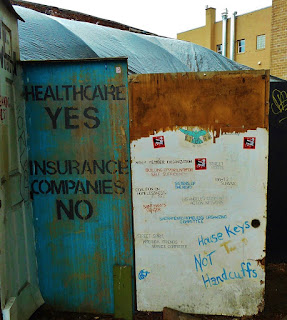June 21, 2016
Minutes
p
|
Bruce Hoffman,
Chair
|
p
|
Woody Dukes
|
a
|
Brock Campbell
|
p
|
Michael
Livingston,
Vice Chair
|
p
|
Bob Hanna
|
p
|
Bill Holmstrom
|
p
|
Sarah Owens,
Secretary-Treasurer
|
p
|
Neal
Kern
|
a
|
Diana Dettwyler
|
p
|
Erma Hoffman
|
a
|
Rebekah Engle
|
a
|
David
Dahle
|
p=present a=absent e=excused
Residents: Deb Comini, Carla Loecke, Mary Anne
Spradin,
Organizations: Susan Gallagher, Gallaghers Fitness Resources; Maurice
Anderson, St. Mark Lutheran Church
City and County Representatives: Officer Kevin
Hill; Kevin Hottmann, Traffic Engineer, Julie Warnke, Planner, Anthony Gamallo,
Planner, Keith Whisenhunt, Consultant, Public Works Department
Guest: none
The regular meeting of the CanDo Board of
Directors was called to order at 6:00 p.m. on Tuesday, June 21, 2016, at the
First Christian Church at 685 Marion Street NE, Salem. Bruce Hoffman was in the
chair and Sarah Owens acted as Secretary.
The minutes of the May meeting were approved unanimously.
In public comment Bruce Hoffman called for
nominations for the City’s various
volunteer recognition awards, due by July 13, and reminded everyone that
the U.S. Olympic Track and Field trials will open June 30 in Salem
with a men’s and women’s 20K race walk beginning and ending at the Capitol. He also reported that David Dahle had agreed
to undertake organizing a National
Night Out event for CANDO on August 2.
Susan Gallagher invited the board to participate
in this year’s High
Street Hustle on August 13, a walk/run event that last year raised $30K for
enhanced heart disease prevention and education in Marion and Polk counties.
Julie Warnke introduced her colleague Anthony
Gamallo, who will be working on the Maple-Winter Street Family Friendly Bikeway,
which is now in the planning phase. She informed
the board that the consultant had been hired, and, despite the traffic counter
being stolen, Public Works had gathered the data they needed (time-of-day
volumes and intersection activity while school was in session) for the
consultant. They are at this point just
waiting for the notice
to proceed. As a side note, Julie
said that a bike-pedestrian counter placed mid-May in the middle of the Union
Street pedestrian bridge appears to have recorded upwards of 2500 crossings per
day, with a significant spike likely caused by the first On
Your Feet Friday of the season.
Erma Hoffman commented that she had met with Toni
Whitler (Public Works, Parks) to discuss additional matching grant opportunities
relating to CANDO’s Pringle Park project and that the City was probably going to replace
the two tools stolen from the bike-repair station at Riverfront Park. She also suggested that the board might want
to consider applying for a grant to install a bike-repair station at
Minto-Brown Island Park.
The board heard a presentation on plans for
construction affecting CANDO by Kevin Hottman, Public Works Department, with
contributions from Keith Whisenhunt and Julie Warnke. Among other projects discussed was the Mission
Street Structural Rehabilitation Project, which will this summer repave/grind
Mission Street between Commercial and 12th Streets, upgrade sidewalk
ramps at Winter and Mission Streets to ADA standards and install bike-specific signals
at the intersection.
Also discussed was the Broadway and Liberty
Streets NE Intersection Project, which will realign Liberty Street with
Broadway to form a T-intersection. The improvements include replacing the
traffic signal, installing fiber optic interconnect to Market Street, and
improving the pedestrian crossings by modifying the southbound right turn lane
at Liberty Street.
Also discussed was the Union Street NE/Commercial
Street NE Traffic Signal Improvements Project, which will install a traffic
signal at the Union Street NE/Commercial Street NE Intersection to allow for
better pedestrian and bicycle access connecting Downtown with the West Salem
and North Salem areas. The project will add a turn lane on eastbound Union
Street, west of Commercial Street, with a pedestrian safety island. The project is currently in preliminary
design with construction anticipated in 2017 with completion by October 2017. Although $1,133,000 in Federal and Salem
Urban Renewal Agency funds are available for the project, the City has applied
for additional funds hoping to be able to avoid using of all or some of the URA
funds allocated to the project.
The board was reminded that the City would be
looking to see how well residents accepted and used the Bicycle Lanes coming to High
and Church Streets, as the ultimate plan was to make those streets two-way. If it appears there is a demand for the bike
lanes, they are more likely to be retained when the streets go two-way. Otherwise, they may be lost to parking spaces
in the conversion.
Officer Kevin Hill, who has taken over leadership
of the Downtown Enforcement Team from Officer Vanmeter, spoke briefly of his
experience and training (e.g., with the Narcotics and SWAT teams and as a
firearms instructor) and the need for a different, more problem-solving
approach to policing on the DET, which he said he is enjoying learning
about. Among the administrative matters
he has been working on are plans to incorporate two additional officers,
increase coverage to seven days a week, and gradually increase the rotation on
DET from two to four years.
In new business, Woody Dukes’s Motion
regarding SPR-ADJ-DR16-09 to authorize him as Land Use Chair to speak with
Ward 1 Councilor Chuck Bennett on behalf of the Board in opposition to the
proposed drive-through at 205 Church Street SE was tabled by unanimous consent
in light of the recent email from Planner Aaron Panko saying that the city
traffic engineering section had requested that the applicant provide additional
information clarifying the traffic impact for the proposed development, and
that talking with Councilor Bennet “could be” considered a prohibited ex parte contact.
There being no other business before the board,
the meeting of the Board of Directors adjourned at 7:13 p.m.

















